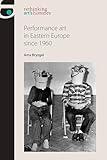Performance art in Eastern Europe since 1960 / Amy Bryzgel.
Series: Rethinking art's historiesPublisher: Manchester : Manchester University Press, 2017Copyright date: ©2017Description: xvii, 366 pages : illustrations (some color) ; 24 cmContent type:- text
- unmediated
- volume
- 9781784994211
- 1784994219
- 9781784994228
- 1784994227
| Item type | Current library | Collection | Call number | Status | Date due | Barcode | |
|---|---|---|---|---|---|---|---|
 Book
Book
|
CGLAS Library | Yellow | 709.040755 BRY (Browse shelf(Opens below)) | Available | 08978 |
Browsing CGLAS Library shelves, Collection: Yellow Close shelf browser (Hides shelf browser)

|

|

|

|

|

|

|
||
| 709.04075 WIL Conceptual art in Britain 1964-1979 / | 709.040752 JON Body art/performing the subject / | 709.040755 AND Performance : live art since the 60s / | 709.040755 BRY Performance art in Eastern Europe since 1960 / | 709.040755 CAR Re:akt! : reconstruction, re-enactment, re-reporting | 709.040755 GOL Performance art : from futurism to the present / | 709.040755 HEA Live : art and performance / |
Includes bibliographical references (pages 340-345) and index.
Sources and origins -- The body -- Gender -- Politics and identity -- Institutional critique.
This volume presents the first comprehensive academic study of the history and development of performance art in the former communist countries of Central, Eastern and South Eastern Europe since the 1960s. Covering 21 countries and more than 250 artists, this text demonstrates the manner in which performance art in the region developed concurrently with the genre in the West, highlighting the unique contributions of Eastern European artists. The discussions are based on primary source material-interviews with the artists themselves. It offers a comparative study of the genre of performance art in countries and cities across the region, examining the manner in which artists addressed issues such as the body, gender, politics and identity, and institutional critique.

